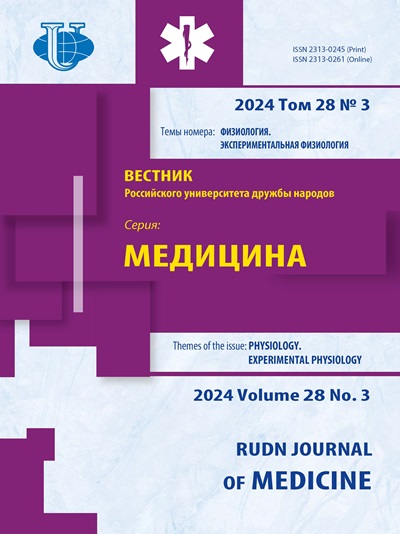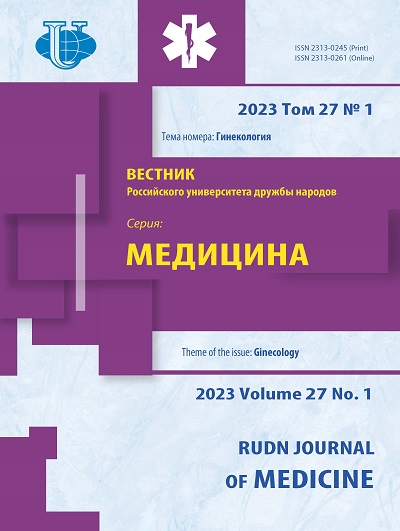Тренировка мышц тазового дна как метод профилактики и лечения несостоятельности тазового дна и генитального пролапса
- Авторы: Самсонова И.А.1, Гайфулин Р.Ф.1, Токтар Л.Р.1, Оразов М.Р.1, Камарова З.Н.1, Ли К.И.1, Пак В.Е.1
-
Учреждения:
- Российский университет дружбы народов
- Выпуск: Том 27, № 1 (2023): ГИНЕКОЛОГИЯ
- Страницы: 39-45
- Раздел: ГИНЕКОЛОГИЯ
- URL: https://journals.rudn.ru/medicine/article/view/34087
- DOI: https://doi.org/10.22363/2313-0245-2023-27-1-39-45
- EDN: https://elibrary.ru/SFNUIN
Цитировать
Полный текст
Аннотация
Актуальность. Несостоятельность тазового дна и пролапс тазовых органов на сегодняшний день являются существенной проблемой - даже начальные проявления несостоятельности тазового дна могут привести к снижению качества сексуальной жизни, снижению активности, а затем к социальной изоляции и снижению самооценки женщины. В связи с ростом общей продолжительности жизни, растет и заболеваемость. Одним из наиболее популярных методов консервативного лечения несостоятельности тазового дна является тренировка мышц тазового дна. Целью данного обзора является консолидация разрозненных сведений об эффективности тренировки мышц тазового дна в качестве профилактики и лечения дисфункции тазового дна. Материалы и методы . При написании обзора были проанализированы и систематизированы публикации из баз данных PubMed и Google Scholar с января 2019 года. Результаты и обсуждение . Тренировка мышц тазового дна является одним из наиболее перспективных методов неинвазивного лечения пролапса тазовых органов. Она может принимать различные формы и представлена целым рядом различных техник: от простых кратковременных сокращений мышц и упражнений Кегеля до более сложных и высокотехнологичных методов с использованием электромиостимуляции и биологической обратной связи. Тем не менее, время введения и метод тренировки мышц тазового дна должны быть тщательно продуманы, чтобы получить максимальный результат. Выводы . На основании проведенного исследования можно сделать вывод, что введение тренировки мышц тазового дна в рамках дородовой помощи и в антенатальном периоде является наиболее целесообразным способом профилактики несостоятельности тазового дна и генитального пролапса. Для подтверждения гипотезы необходимы дальнейшие исследования.
Об авторах
И. А. Самсонова
Российский университет дружбы народов
Автор, ответственный за переписку.
Email: iris.samsonova@gmail.com
ORCID iD: 0000-0002-9403-2921
Москва, Российская Федерация
Р. Ф. Гайфулин
Российский университет дружбы народов
Email: iris.samsonova@gmail.com
ORCID iD: 0000-0002-2485-3994
Москва, Российская Федерация
Л. Р. Токтар
Российский университет дружбы народов
Email: iris.samsonova@gmail.com
ORCID iD: 0000-0002-8593-3939
Москва, Российская Федерация
М. Р. Оразов
Российский университет дружбы народов
Email: iris.samsonova@gmail.com
ORCID iD: 0000-0002-1767-5536
Москва, Российская Федерация
З. Н. Камарова
Российский университет дружбы народов
Email: iris.samsonova@gmail.com
ORCID iD: 0000-0002-8800-1467
Москва, Российская Федерация
К. И. Ли
Российский университет дружбы народов
Email: iris.samsonova@gmail.com
ORCID iD: 0000-0003-2391-1600
Москва, Российская Федерация
В. Е. Пак
Российский университет дружбы народов
Email: iris.samsonova@gmail.com
ORCID iD: 0000-0001-5485-3883
Москва, Российская Федерация
Список литературы
- Weintraub AY, Glinter H, Marcus- Braun N. Narrative review of the epidemiology, diagnosis and pathophysiology of pelvic organ prolapse. Int Braz J Urol. 2020;46(1):5-14. doi: 10.1590/S1677-5538. IBJU.2018.0581
- Hong MK, Ding DC. Current treatments for female pelvic floor dysfunctions. Gynecol Minim Invasive Ther. 2019;8(4):143-148. doi: 10.4103/GMIT.GMIT_7_19
- Woodley SJ, Hay-S mith EJC. Narrative review of pelvic floor muscle training for childbearing women - why, when, what, and how. Int Urogynecol J. 2021;32(7):1977-1988. doi: 10.1007/s00192-021-04804-z
- Woodley SJ, Lawrenson P, Boyle R, Cody JD, Mørkved S, Krenohan A, Hay-S mith EJC. Pelvic floor muscle training for preventing and treating urinary and faecal incontinence in antenatal and postnatal women. Cochrane Database Syst Rev. 2020;2021(3). doi: 10.1002/14651858.CD007471.pub4
- Hagen S, Elders A, Stratton S, Sergenson L, Bugge C, Dean S, Hay- Smith J, Kilonzo M, Dimitrova M, Abdel-Fattah M, Agur W, Booth J, Glazener C, Guerrero K, McDonald A, Norrie J, Williams LR, McClurg D. Effectiveness of pelvic floor muscle training with and without electromyographic biofeedback for urinary incontinence in women: Multicentre randomised controlled trial. BMJ. 2020;371:1-11. doi: 10.1136/bmj.m3719
- Navarro-B razález B, Vergara-Pérez F, Prieto-G ómez V, Sánchez- Sánchez B, Yuste-S ánchez MJ, Torres-Lacomba M. What influences women to adhere to pelvic floor exercises after physiotherapy treatment? A qualitative study for individualized pelvic health care. J Pers Med. 2021;11(12). doi: 10.3390/jpm11121368
- Maher RM PT, PhD; Iberle J PT, DPT. Concurrent Validity of Noninvasive Coccygeal Motion Palpation and Transabdominal Ultrasound Imaging in the Assessment of Pelvic Floor Function in Women. Journal of Women’s Health Physical Therapy 2020; 44(4):176-181. doi: 10.1097/JWH.0000000000000175
- Takaoka S, Kobayashi Y, Taniguchi T. Effect of pelvic floor muscle training program in reducing postpartum levator hiatus area in Japanese women: A prospective cohort study using three-d imensional ultrasonography. Japan J Nurs Sci. 2020;17(4):1-13. doi: 10.1111/jjns.12346
- Fitz FF, Gimenez MM, de Azevedo Ferreira L, Matias MMP, Bortolini MAT, Castro RA. Pelvic floor muscle training for female stress urinary incontinence: a randomised control trial comparing home and outpatient training. Int Urogynecol J. 2020;31(5):989-998. doi: 10.1007/s00192-019-04081-x
- Wang X, Xu X, Luo J, Chen Z, Feng S. Effect of app-based audio guidance pelvic floor muscle training on treatment of stress urinary incontinence in primiparas: A randomized controlled trial. Int J Nurs Stud. 2020;104:103527. doi: 10.1016/j.ijnurstu.2020.103527.
- Maxwell M, Berry K, Wane S, Hagen S, McClurg D, Duncan E, Abhyankar P, Elders A, Best C, Wilkinson J, Mason H, Fenocchi L, Calveley E, Guerrero K, Tincello D. Pelvic floor muscle training for women with pelvic organ prolapse: the PROPEL realist evaluation. Heal Serv Deliv Res. 2020;8(47):1-104. doi: 10.3310/hsdr08470
- Sam E, Cinislioglu AE, Yilmazel FK, Demirdogen SO, Yilmaz AH, Karabulut I. Is biofeedback-a ssisted pelvic floor muscle training superior to pelvic floor muscle training alone in the treatment of dysfunctional voiding in women? A prospective randomized study. Int Braz J Urol. 2022;48(3):501-511. doi: 10.1590/S1677-5538. IBJU.2021.0687
- Liu YJ, Ting SWH, Hsiao SM, Huang CM, Wu WY. Efficacy of Bio-A ssisted Pelvic Floor Muscle Training in Women with Pelvic Floor Dysfunction. Vol. 251. Elsevier Ireland Ltd; 2020. doi:10.1016/j. ejogrb.2020.04.050
- Hagen S, Bugge C, Dean SG, Elders A, Hay-S mith J, Kilonzo M, McClurg D, Abdel- Fattah M, Agur W, Andreis F, Booth J, Dimitrova M, Gillespie N, Glazener C, Grant A, Guerrero KL, Henderson L, Kovandzic M, McDonald M, Norrie J, Sergenson N, Stratton S, Taylor AW, Louise R. Basic versus biofeedback-m ediated intensive pelvic floor muscle training for women with urinary incontinence: The opal RCT. Health Technol Assess (Rockv). 2020;24(70):1-143. doi: 10.3310/hta24700
- NICE Guidance - Urinary incontinence and pelvic organ prolapse in women: management. BJU Int. 2019 May;123(5):777-803. doi: 10.1111/bju.14763. PMID: 31008559
- Bø K, Anglès- Acedo S, Batra A, Brækken IH, Chan YL, Jorge CH, Kruger J, Yadav M, Dumoulin C. International Urogynecology Consultation Chapter 3 Committee 2; Conservative Treatment of Patient with Pelvic Organ Prolapse: Pelvic Floor Muscle Training. Vol. 33. Springer International Publishing; 2022. doi: 10.1007/s00192-022-05324-0
- Nyhus M, Mathew S, Salvesen, Salvesen K, Stafne S, Volløyhaug I. Effect of preoperative pelvic floor muscle training on pelvic floor muscle contraction and symptomatic and anatomical pelvic organ prolapse after surgery: randomized controlled trial. Ultrasound Obstet Gynecol. 2020;56(1):28-36. doi: 10.1002/uog.22007
- Duarte TB, Bø K, Brito LGO, Bueno SM, Barcelos TMR, Bonacin MAP, Ferreira CHJ. Perioperative pelvic floor muscle training did not improve outcomes in women undergoing pelvic organ prolapse surgery: a randomised trial. J Physiother. 2020;66(1):27-32. doi: 10.1016/j.jphys.2019.11.013
- Siahkal SF, Iravani M, Mohaghegh Z, Sharifipour F, Zahedian M. Maternal, obstetrical and neonatal risk factors’ impact on female urinary incontinence: a systematic review. Int Urogynecol J. 2020;31(11):2205-2224. doi: 10.1007/s00192-020-04442-x
- Brennen R, Frawley HC, Martin J, Haines TP. Group-based pelvic floor muscle training for all women during pregnancy is more cost-effective than postnatal training for women with urinary incontinence: cost-effectiveness analysis of a systematic review. J Physiother. 2021;67(2):105-114. doi: 10.1016/j.jphys.2021.03.001
- Wesnes SL, Seim E. Birthweight and urinary incontinence after childbirth: a systematic review and meta-analysis. Eur J Obstet Gynecol Reprod Biol X. 2020;8:100115. doi: 10.1016/j.eurox.2020.100115
- Szumilewicz A, Kuchta A, Kranich M, Dornowski M, Jastrzȩbski Z. Prenatal high-low impact exercise program supported by pelvic floor muscle education and training decreases the life impact of postnatal urinary incontinence: A quasiexperimental trial. Med (United States). 2020;99(6). doi: 10.1097/MD.0000000000018874
- Pires TF, Pires PM, Moreira MH, Gabriel, Ronaldo ECD, João PV, Viana SA, Viana RA. Pelvic Floor Muscle Training in Female Athletes: A Randomized Controlled Pilot Study. Int J Sports Med. 2020;41(4):264-270. doi: 10.1055/a-1073-7977
- Sigurdardottir T, Steingrimsdottir T, Geirsson RT, Halldorsson TI, Aspelund T, Bø K. Can postpartum pelvic floor muscle training reduce urinary and anal incontinence?: An assessor-blinded randomized controlled trial. Am J Obstet Gynecol. 2020;222(3):247. e1-247.e8. doi: 10.1016/j.ajog.2019.09.011
- Wu X, Zheng X, Yi X, Lai P, Lan Y. Electromyographic Biofeedback for Stress Urinary Incontinence or Pelvic Floor Dysfunction in Women: A Systematic Review and Meta-A nalysis. Adv Ther. 2021;38(8):4163-4177. doi: 10.1007/s12325-021-01831-6
















